How to Grind Concrete Floors
Grinding a concrete floor is an essential task if you're looking to refurbish concrete surfaces, install flooring or give large slabs a new lease on life. Professional contractors rely on concrete grinding to remove old paint, epoxy coatings, and minor surface imperfections from a concrete surface before applying surface coatings. But knowing when and how to use a concrete grinder can be tricky.
This guide will explain how to grind concrete floors using different types of concrete grinders, as well as which type of concrete grinder you'll need for your particular renovation project. With the right tools and knowledge, you can grind your concrete floors quickly and efficiently – leaving you with a perfectly prepped concrete surface for whatever job you have in mind.
What is Concrete Grinding?
Before learning how to start concrete grinding, you must know what a concrete grinder is and how it works. If you haven't guessed already, a concrete grinder is very much like a power sander. Grinders come with different concrete grinding attachments for various applications, such as grinding rough concrete surfaces or other concrete coatings.
Although concrete grinders differ slightly in their processes, all styles use an abrasive disc or grinding wheel to repeatedly rub over an area of concrete until it reaches a satisfactory height and smoothness.
Which Industries Use Concrete Grinding?
Concrete grinding is an incredibly versatile technique that finds utility in a wide array of applications in both residential and commercial settings. It is particularly valuable in environments such as warehouses, factories, and manufacturing plants, where the durability and smoothness of the concrete surface are of the utmost importance.
Through specialized grinding equipment, concrete surfaces can be meticulously prepared, ensuring enhanced safety, aesthetics, and longevity. Whether it's for leveling uneven floors, removing coatings, or polishing surfaces to a glossy finish, concrete grinding offers a comprehensive solution that meets the diverse needs of various industries.
Is Concrete Grinding Complicated?
The most challenging part of grinding a concrete floor is assessing the job. How deep must you grind? What’s the flooring texture? How large is the area? What finish do you need?
Answers to these questions will tell you the type of concrete grinder, the grit, and roughly how long it will take. From there using a concrete grinder is relatively simple.
What Are The Benefits of Concrete Grinding?
Concrete grinding offers many advantages over other methods of floor preparation. It can be used to remove lippage caused by poor installation or wear and tear over time, as well as deep scratches that can't be addressed with other methods. The process can also be used to level uneven floors, prepare the floor for additional treatments such as staining or sealing, and provide a smooth surface for polishing.
Depending on the job's specific needs, the cost of concrete grinding can also be lower than other methods. This makes it an attractive option for those working with a limited budget. With its many advantages, the concrete grinding process is becoming increasingly popular as a viable floor preparation method.
In addition to being a cost-effective way to prepare a concrete floor, grinding is also relatively quick and easy when compared to other methods. This makes it an ideal choice for those looking to get the job done quickly and efficiently.
Additionally, many professional contractors now offer concrete grinding services, making it easier than ever for homeowners and businesses to take advantage of this method.
In short, concrete grinding offers a range of benefits that make it an attractive option for those looking to prepare a floor quickly and efficiently. With the right tools and materials, it can be an effective way to prepare a concrete floor coating or surface for polishing or other treatments.
Whether you're looking to level an uneven floor or prepare it for sealing or polishing, proper concrete grinding can make all the difference in the results. Take the time to research your options and determine what method will work best for you. By taking these steps, you can ensure that your concrete floor is prepared correctly and looks its best.
What Different Grinding Attachments Are There?
When it comes to concrete grinding, different types of grinders can be used for various applications. The most common type of grinder is a mechanical wheel grinder, which uses an abrasive disc or grinding wheel to smooth down the surface.
There are also vacuum-mounted grinders, which are designed to suck up dust and debris while grinding the concrete, as well as edging grinders for grinding up against the edges of a wall or other surface.
There are also angle grinders with different blades for various applications, such as cutting through concrete or masonry, as well as cup wheel grinders that can be used to remove coatings from large concrete slabs.
How do You Prepare for Concrete Grinding?
Before beginning any concrete grinding project, it’s important to make sure the area is prepped properly. This includes cleaning up any debris and making sure the surface is free of any imperfections that could affect the quality of the final result.
It’s also important to check for cracks or other signs of damage on the concrete surface before starting work. If repairs need to be made, they should be done before any grinding takes place. Additionally, you’ll need to make sure that any protective gear, such as safety glasses and dust masks, are worn during the grinding process.
What is the Best Way to Apply a Finish After Concrete Grinding?
Once you’ve finished grinding the concrete surface, it’s time to apply a finish. This could be a sealant, wax, or epoxy coating depending on the desired result. Make sure that the concrete surface is completely dry before applying any type of finish, as moisture can cause issues with adhesion.
When it comes to applying finishes, the best way to ensure an even coverage and smooth surface is to use a microfiber paint roller. Once the finish has been applied, let it dry for 24 hours before any traffic is allowed on the surface.
By following these steps, you'll have a perfectly prepped concrete floor that's ready for whatever project you have in mind. With the right tools and knowledge, grinding your concrete floor can be a quick and efficient process.

What Type of Finish Should I use on a Polished Concrete Floor?
A polished concrete slab or floor can be finished with a variety of sealers, waxes, and epoxy coatings depending on the desired look. Generally speaking, a matte or satin finish will provide an elegant, understated look that won't show dirt easily For a sleek, glossy finish, you can opt for a high-gloss sealer.
In addition to aesthetic considerations, it's important to make sure the sealer or coating you choose is suitable for the type of floor and traffic it will receive. For instance, if your polished concrete floor is exposed to heavy foot traffic, you'll want to select a durable finish that can stand up to wear and tear.
Regardless of the type of finish you choose, it's important to note that proper maintenance is key to keeping a polished concrete floor looking its best. Regular cleaning and resealing or waxing can help to keep your new floor in top condition for years to come. With the right care, your polished concrete floor will look beautiful for years to come.
What Types of Surfaces Can Be Ground Using a Concrete Grinder?
Concrete grinders are mainly used for grinding down rough or unfinished concrete surfaces, but they can also be used to smooth out other types of surfaces as well.
When using a concrete grinder on hard surfaces such as metal or stone, it’s important to make sure that the right grit diamond wheel is used to ensure a smooth finish. For softer materials like wood or tiles, an abrasive wheel will work better. Different types of attachments are available for different applications as well, allowing you to customize the grinder for the job at hand.
By choosing the right type of concrete grinder and using it correctly, you can be sure that your chosen surface will be ground down quickly and smoothly with minimal effort. With this knowledge in hand, you’ll be ready to start grinding any surface in no time!
Can I use a Concrete Grinder on Wood or Tile Floors?
No, you should not use a concrete grinder machine on wood or tile floors, as it may cause damage or create an uneven surface. Instead, you should use a wood floor sander or tile floor grinder machine specifically designed for these purposes.
For instance, when sanding wood floors, you'll want to choose the right belt and grits that won't gouge or tear the material. Similarly, it's important to consider the type of tile floor when selecting a grinder, as some materials are more brittle than others and require a lower speed.
Be sure to read the manufacturer's instructions carefully before using any type of floor grinder on these surfaces. Regardless of the material, it is important to note that some special care should be taken when working with dust-producing tools around delicate surfaces such as wood or tile floors. Make sure to utilize dust extraction systems or vacuums to prevent any damage.
What Are the Most Common Mistakes Made When Grinding Concrete?
One of the most common mistakes made when grinding concrete is not using the right type of grinder for a job. Using an angle grinder on a rough concrete surface, for example, can result in an uneven finish or even damage to the material itself. It’s important to make sure that the right type of grinder is used for a job.
Not wearing protective gear is also a common mistake when grinding concrete. Without proper protection, particles and dust can get into your eyes or lungs and cause irritation or even serious health issues.
Additionally, not changing out the wheel on the grinder regularly enough can lead to an uneven finish as well.
By taking the time to prepare, use the right tools, and wear the proper safety gear, you can ensure that your concrete grinding project will go smoothly from start to finish. With a little bit of knowledge and the right equipment, you’ll be able to create a perfect finish on any surface!
What are the Different Types of Concrete Grinding Processes?
The grinding process you use will depend on the way you prefer to go about it. Grinder models designed for wet grinding include a water tank, so they are easier on the equipment and produce less dust.
In contrast, dry grinding is a much less messy method of grinding. Dry grinders are often equipped with dust containment devices, whereas wet grinders require manual removal of dust and water mixtures.
Pros and Cons of Wet Grinding
Wet grinding is typically the preferred method for preparing concrete surfaces, as it offers a greater degree of accuracy and smoothness. It also leaves behind fewer scratches on the ground surface than dry grinding. In addition, wet grinding uses relatively low-powered equipment, making it more affordable to operate.
On the downside, wet grinding can create a lot of slurry and splatter, leaving your workspace messier than if you were to use dry grinding. It also requires an external water source for the grinder itself, which can be expensive in certain locations with limited access to water. Additionally, wet grinders must be carefully monitored due to their susceptibility to moisture damage if not stored correctly.
Pros and Cons of Dry Grinding
Dry grinding is a less time-consuming process than wet grinding, as it does not require an external water source. In addition, since it's a much cleaner process, it leaves behind fewer scratches on the finished surface.
However, there is some trade-off in terms of accuracy and smoothness when compared to wet grinding. Dry grinders can also be more expensive and harder to maintain due to the lack of a water tank, which can be prone to damage if not properly stored. Additionally, dry grinders are more susceptible to dust contamination.
When Should I Use Each Type of Grinder?
The type of grinding process you choose to use will depend on the results you're looking for. If you want a smoother, more accurate finish, then wet grinding is typically your best bet. On the other hand, if you need to get a job done quickly and don't mind sacrificing some accuracy or smoothness to do so, then dry grinding may be the more suitable option.
Ultimately, it's important to remember that the type of grinding process you choose will depend on the project and the results you want to achieve. Armed with this knowledge, you should be able to decide which grinder is best suited for your needs.
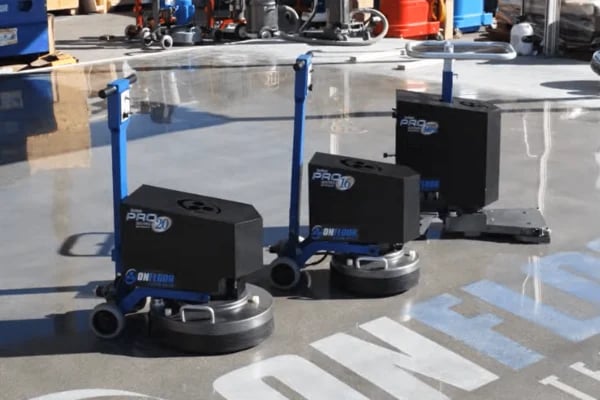
What Are The Different Types of Concrete Grinders?
Knowing what concrete floor grinder to use for a particular job is key. Here are some of the most commonly used concrete grinders:
Portable Grinder
A portable grinder is a handheld power tool used for grinding, cutting, and polishing concrete floors.
As long as the appropriate grinder wheels are used according to the manufacturer's instructions, these versatile tools can be utilized to remove paint, rust, or mortar, cut ceramic tiles, stone, or concrete, polish metal, and clean, cut, or sand wood, among other tasks.
Walk-behind Grinder
In a walk-behind grinder, you push or pull the machine to grind and smooth concrete surfaces. There is an ergonomic, adjustable handle on all walk-behind grinders, so they can be operated at various heights and angles.
Because these grinders cover more area faster than handheld grinders, they are ideal for larger jobs. In addition, these machines are useful for tackling difficult areas that are otherwise hard to reach by hand or that cannot be reached with a handheld grinder.
Planetary Concrete Grinder
Like planets orbiting the sun, planetary discs move independently of one another while they circle a center point, hence the name.
Planetary grinders operate more evenly than traditional hand-held grinders, making them ideal for achieving uniformity on large surfaces. It’s high torque power also allows the machine to grind faster and achieve better results than manual grinders.
Single-disc Concrete Grinder
A single-disc concrete grinder is simple yet efficient. The grinding wheel consists of a single disc that rotates to grind the concrete floor.
In addition to walk-behind models that use a single disc, hand-held models are also available. There are several applications for a single-disc concrete grinder, such as on walkways, porches, and large entranceways.
Dual-disc Concrete Grinder
Dual-disc concrete grinders use two discs that spin independently of each other. This allows you to grind the floor more efficiently. As a general rule, dual-disc grinders are walk-behind machinery and can cover twice the amount of ground as a single-disc model in the same period.
Dual-disc grinders are a popular choice for contractors since they finish driveways and garages faster than single-disc grinders. It's smaller and lighter than a planetary concrete grinder, making it easier to handle and transport.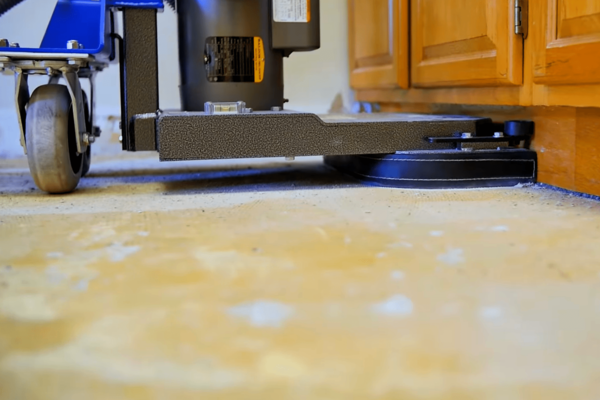
Angle Grinder
If you intend to grind close to a wall or other object abutting the concrete, an angle concrete grinder is necessary. In most cases, traditional disc grinders won't get much closer than an inch away from a wall.
You can purchase or rent a small, hand-concrete grinder if you have a minimal area of space or if you need a small grinder to grind, such as a hump in a closet or garage floor.
What is Grit?
In this context, grit isn't referring to your courage, resolve, and strength of character, though you might need plenty if faced with a particularly tough job. The grit refers to the number, size, and makeup of the material on your grinding wheel.
Discs are made from tungsten carbide or silicon carbide material, and some include diamond bits.
Fine Grit
A fine grit will have smaller pieces of abrasive material on the pad, and because they are smaller, there will be more of them on the same size pad. You might start a job with a large grit to get close to your required depth, then move to a fine grit to finish grinding.
You could switch to a fine grit after starting with a large grit to avoid having to re-level or re-build the floor in case you grind too deep.
Diamond Grit and Diamond Tools
Diamond grinding is a process of using special tools with diamond blades to abrade and level the surface of the concrete. It is often used in combination with other abrasive processes, such as shot blasting or scarifying, to prepare a concrete floor for polishing, sealing, or other treatments.
Diamond grinding is effective at removing lippage, unevenness caused by poor installation or wear and tear over time, and deep scratches that can't be addressed with other methods. The process requires some skill and knowledge, so it is usually best to leave it to a professional if you don't have prior experience.
Additionally, diamond grinding tools are expensive, so make sure to research the cost of rental or purchase before undertaking this project. Despite its cost, diamond grinding is considered one of the most effective ways to prepare a concrete floor for polishing. For those willing to invest, it is well worth the effort.
Large Grit
A large grit will have larger pieces of abrasive material on the disc, and because the size of the pad is 10 inches, there will be fewer pieces. You'll need a large grit when you grind to a deeper depth. The larger the grit, the more material is removed with each pass.
Finish Grit
Finish grit will have the smallest pieces of abrasive material and more of them. You will need a finishing grit to resurface a garage floor or a patio if you want to create a smooth surface. You might also need a finishing grit if you plan to apply an epoxy coating or paint the surface.
You wouldn't need a finishing grit if you plan on laying a carpet or installing a wood or tile floor, as a smoother surface would actually make the job harder. For this job, you want a slightly rough surface to help create a tighter bond between the flooring material and the concrete
How Should I Determine What Grit of Grinding Wheel is Needed?
One of the most commonly asked questions is "What type of grit should I use?". The selection of the right grit for a grinding wheel depends on the type of work being done. Generally, coarser grits such as 36 or 40 are best for aggressive material removal, while finer grits like 60 or 80 are preferable for finishing operations.
You'll also want to consider the hardness of the material you're working with and the quality of the surface finish you're trying to achieve. If you're unsure, it's best to start with the coarser grit and work your way up until you get the desired result.
It's also important to remember that different grinding wheels may require a different grit than others, so be sure to read the manufacturer's instructions carefully if you're uncertain.
In What Order Should I Use Multiple Grits While Grinding a Concrete Floor?
The order in which you use multiple grits while grinding a concrete floor depends on the kind of work you need to do. Generally, it's best to start with the coarsest grit available and work your way up to finer ones for finishing operations. You'll also want to consider the hardness of the material you're working with, the type of grinder or tool you're using, and the desired surface finish.
As a general guide, begin with 36 grit to remove any existing coatings or high spots before progressing up to 40-60 grit for surface preparation. For finer grinding work, use 80-120 grit to smooth out any remaining imperfections and achieve a polished look. Finally, 180-220 grit or higher can be used for polishing and buffing. As always, make sure to read the manufacturer's instructions carefully before beginning your project.
What is Soft Concrete?
Soft concrete is a type of concrete that has not fully hardened and is more prone to gouging or scratching. You should use a fine grit when grinding soft concrete to reduce the risk of damaging it further.
Finally, once you are finished grinding the concrete floor, make sure you clean up any dust or debris before leaving the area. A thorough vacuum will help get rid of any remaining dust.
Tips for Concrete Grinding
There are a lot of tips we could give about concrete grinding, but here are some of the most important ones to remember:
Always wear protective gear, including a mask, hearing protection, and safety glasses. Once you begin concrete grinding, you must keep the concrete grinder moving regardless of the type of grinder you are using. This will prevent uneven areas or low spots that you will need to cover with a levelling compound afterward.
Make multiple passes with smooth, even motions. If you're grinding a slab in a high spot, you should mark the diameter and draw a circle around the area. This will help you keep the concrete grinder from straying outside the area.
How long does concrete grinding take?
The amount of time to complete concrete grinding depends on many factors. Concrete grinding and sealing for an existing slab can typically take three to five days, but that figure may be pushed out if there is a new pour involved.
Other factors that influence the length of time include the space's size and shape, the sealing finish needed, and any necessary repairs or edgework.

How much does it cost to grind a concrete floor?
As far as the concrete grinding cost is concerned, many variables should be considered, such as the size of the floor, the level of preparation required, the type of grinder used, and the location where the project will be undertaken. It is generally accepted that the cost per square foot can range between $2 and $6.
Is it hard to learn to grind concrete?
Learning how to grind concrete may be intimidating, but with the right tools and a bit of practice, it is possible to master. Make sure to get familiar with the type of grinder you're using before beginning your project, wear protective gear for safety reasons, and take your time as you work your way across the floor.
It's also important to note that grinding concrete floors can be labor-intensive and time-consuming, so it might be well worth the investment to hire a professional if you don't have the experience or patience for such a project. With the right tools and knowledge, however, learning how to grind concrete is doable for any handy DIYer.
Does concrete grinding create a lot of dust?
Yes, concrete grinding can create a significant amount of dust, so it is important to take the necessary safety precautions. Make sure to wear a mask that filters out the fine particles created by the grinder, and use a vacuum attachment whenever possible to minimize the amount of dust in the air.
You may also want to seal off any areas you aren't currently working on and cover furniture and other items that could be damaged by concrete dust. With the right preparations, such as having a shop vac on hand, you can reduce the risks associated with concrete grinding.
Do special safety precautions need to be taken when grinding concrete?
Yes, it is important to take special safety precautions when grinding concrete. Always wear protective eyewear and a dust mask to protect yourself from any particles created by the grinder. You should also avoid wearing loose clothing or jewelry while working, as these may snag on the tools.
Additionally, make sure to keep the grinder away from any flammable materials, because sparks may be created during grinding.
Taking these precautions will help ensure a safe and successful concrete grinding experience. If you're ever uncertain about a particular step in the process, it's best to consult an experienced professional for advice.
Safety should always be your top priority! Once all of the necessary precautions have been taken, you'll be able to complete your project with confidence.

What are some risks I should be aware of with concrete grinding?
Silica Dust
Silica dust is a major safety hazard when it comes to grinding concrete. Silica dust is one of the many byproducts that are produced when a concrete floor is grounded or polished.
Fine dust like this is easily inhaled. As a result, if it gets into your lungs, you run the risk of it permanently affecting your respiratory system.
Silica Dust Control
Given the risks, It’s crucial to stay on top of dust control. One way to do this is with the use of wet rather than dry grinding techniques.
Using water as you clean keeps the dust generated by the process to a minimum and will be more easily disposed of as a slurry rather than having to wait for all the dust itself to settle on its own.
Keep in mind that breathing apparatuses are also necessary tools when grinding or polishing concrete. It is essential to keep them on at all times while using a grinding tool.
Eye Irritation
During the grinding process, it's not just your lungs that suffer from all that dust. When you are grinding or polishing a concrete floor, you need to make sure that you wear adequate eye protection.
Silica dust can also damage or irritate your eyes, so you should always wear safety goggles when grinding to reduce the risks.
Losing Control of Your Tool
It is almost universally known to construction workers that slow and steady is the key to success. In particular, workers who use concrete grinders and polishers need to be very careful when grinding and polishing.
To create a smooth and shiny finish, make sure you make several slow and steady passes. In any case, rushing a job can lead to you losing control of your cutting tool and harming yourself or others. Concrete grinding should always be approached methodically.
How can I find a concrete grinder?
Onfloor Technologies is an industry leader in providing contractors with simple solutions to prepare, resurface, and maintain concrete floors.
If you're ready to purchase a concrete grinder, you can browse our equipment online and schedule a demo.
.jpg?width=657&height=438&name=19242976_1225990064178652_2899699990193970456_o%20(1).jpg)
What Things Should I Look Out For When Buying a Concrete Grinder?
When looking for a concrete grinder, it’s important to consider the type of job that you will be doing. Depending on the size and scope of the project, different grinders may be more suitable than others.
Some key features to look out for are dust collection systems, adjustable speed settings, variable handle heights, and additional accessories such as grinding discs and dust shrouds. Additionally, make sure that the grinder you purchase is compatible with the size of the job you’re trying to do.
It's also important to keep in mind that some grinders require more power than others. If your project involves a large amount of surface area to cover, it might be wise to invest in a more powerful machine. Lastly, consider the budget for your grinder,and research different models to find one that fits within your price range.
By taking into account all of these factors when purchasing a concrete grinder, you will be well on your way to completing a successful project!
How Can I Take Care of My Concrete Grinder?
Maintaining your concrete grinder is important to ensure it lasts for a long time and delivers quality results every time you use it. One of the most important things you should do to keep your grinder in good condition is to clean and lubricate all moving parts regularly.
This will help prevent dust and other particles from getting trapped or clogged in the machine, as well as reduce friction and wear on the moving components.
Inspecting the grinder for any signs of damage or wear is also important. Make sure to check all nuts and bolts to make sure they are securely tightened, and look for any cracks or other visible damage that may need to be repaired. Additionally, it is a good idea to read the instructions provided with your grinder and familiarize yourself with its operation before each use.
Also, make sure you store the grinder in a dry place and avoid exposing it to water or other liquids that could cause damage. Following these tips will help ensure that your concrete grinder is in proper working order for years to come!
All in all...
Concrete grinding is a useful skill for many construction, commercial, and industrial projects. Although there are some risks associated with the process, such as silica dust and eye irritation, these can be avoided or minimized by following proper safety protocols.
To purchase the right grinder for your project, it’s important to consider the size of the job you’ll be doing, the power and speed of the grinder, and your budget. Additionally, regularly cleaning and lubricating the grinder and storing it in a dry place can help extend its life. With these tips in mind, you’ll be sure to have successful concrete grinding projects for years to come!
We pride ourselves on our knowledge of concrete grinding, so if you have any other questions be sure to reach out so we can have an expert efficiently answer any remaining thoughts. Good luck, and thanks for reading!



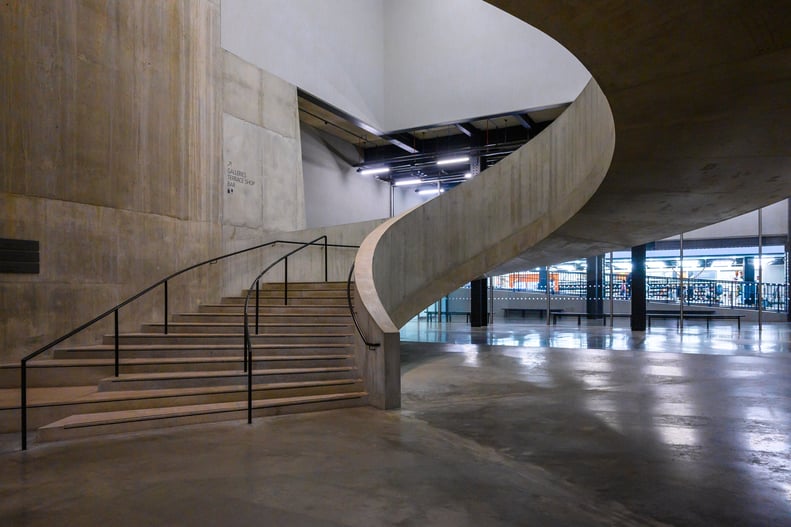
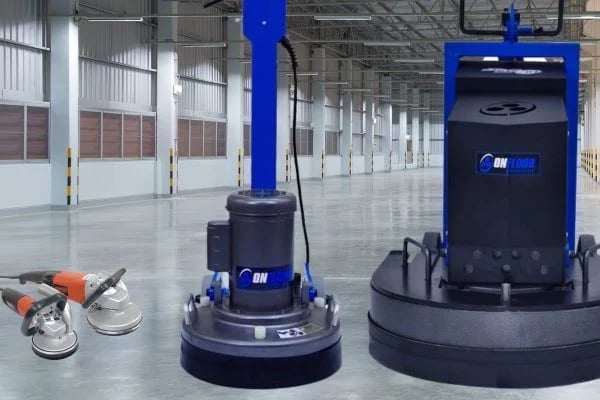
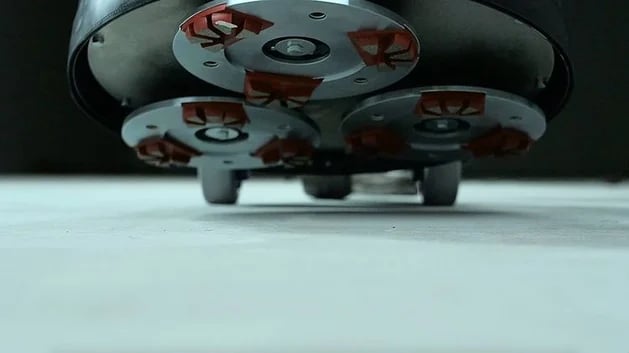


0 comments